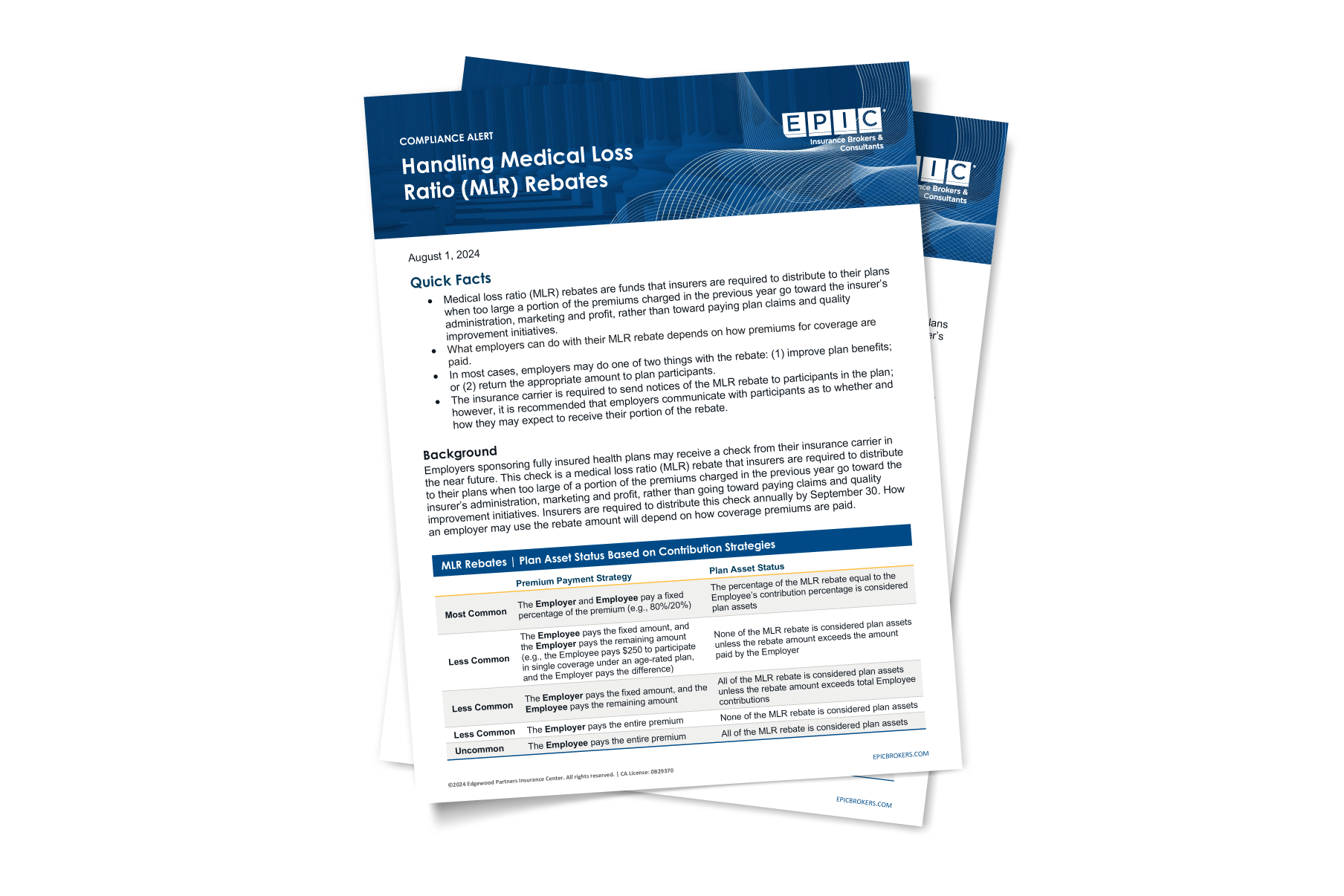Let our team help you navigate the ever-changing benefits compliance landscape each month. Check out this month’s latest alerts, additional updates, and resources hot off the press:
Employee Benefits Compliance Alerts
This month’s Compliance Matters newsletter provides a comprehensive review of the following topics. To obtain your copy, please use the form below to download.

- Group Term Life Insurance Rules
- Court Rules Tennessee PBM Law Is Preempted by ERISA
- 2025 State Regulation Series: California Timely Access to Care
- Employee Benefits Litigation Series: JPMorgan Sued for Alleged Fiduciary Breaches
Download this month’s alerts
Additional Updates & Resources
Reminder! RxDC Reporting Due June 1
Annual Prescription Drug Data Collection (RxDC) reporting is required by June 1 of each year. Reporting for the data from 2024 will be due June 1, 2025. The reporting consists of a plan file (P2), eight data files (D1-D8) and accompanying narratives. Most employer-sponsored health plans rely heavily on their carriers, third-party administrators (TPAs), and pharmacy benefit managers (PBMs) to provide the data necessary, and in many cases, to submit the reporting to Centers for Medicare and Medicaid Services (CMS) on behalf of employer group health plans. To complete the reporting, the carrier or TPA may reach out to employers to ask for information about premium splits (employer and employee contributions) as well as other data required for the D1 file. Once this information is provided, the carrier, TPA and/or PBM may handle the entirety of a group health plan’s RxDC reporting, so employers should make sure to timely respond to such requests. If the employer fails to timely respond with the requested data, or if the carrier/TPA is unwilling to help with the D1 file, the employer may have to submit a P2 and D1 file on their own. For more information on RxDC reporting access our Compliance Matters alert from March 2025.
Final CMS Instructions | Changes to 2026 Simplified Method Determinations
Employers that provide prescription drug coverage are not required to offer creditable coverage but are required to determine whether the coverage is creditable and to communicate creditable status annually to eligible individuals and to the Centers for Medicare & Medicaid Services (CMS). Prescription drug coverage is creditable if the actuarial value of the coverage equals or exceeds the actuarial value of Medicare Part D coverage.
Most plan sponsors have the option to determine creditable status by obtaining an actuarial determination or by using a “simplified method” as defined by CMS. CMS final instructions released in March set forth revised criteria for the simplified method. A plan must meet all of the following to be creditable:
- Must provide reasonable coverage for brand-name and generic prescription drugs and biological products;
- Must provide reasonable access to retail pharmacies; and
- Must be designed to pay on average at least 72% of participants’ prescription drug expenses.
For 2026 plan years, CMS will permit plans to use either the existing simplified determination methodology or the revised simplified determination methodology described above to determine whether prescription drug coverage under their CY 2026 plans is creditable. The final instructions can be found here.
DOL Releases Updated CHIP Notice
On April 9, 2025, the Department of Labor’s (DOL) Employee Benefits Security Administration (EBSA) recently released an updated model notice that employers may use to provide information on premium assistance eligibility under Medicaid or the Children’s Health Insurance Program (CHIP). The notice is available in both English and Spanish.
The Children’s Health Insurance Program Reauthorization Act of 2009 (CHIPRA) requires employers who maintain group health plans in states that provide premium assistance under Medicaid or CHIP to annually notify all employees of potential premium assistance opportunities in the state where an employee lives. To assist employers with their disclosure obligations, EBSA developed a model notice for employers to use. The model notice includes contact information for states that provide Medicaid or CHIP premium assistance programs.
EBSA customarily releases updated versions of the model notice twice a year – usually at the end of January and July – to account for recent changes to the contact information related to various state Medicaid or CHIP programs. In 2025, EBSA released the updated notice in April with a “current as of” date of March 17, 2025.
Employers may distribute the model notice annually with their health plan Summary Plan Description (SPD) or open enrollment materials, so long as the materials are provided to all employees and are provided in compliance with the DOL’s document distribution rules. The technical regulations require the notice to be separate from other plan materials so that it is easily distinguishable, and the importance of the notice is clear.
Monthly FAQ: What coverage is considered “preventive” and therefore eligible for first-dollar coverage to maintain HSA eligibility?
The general rule is that any healthcare coverage that the participant does not pay fair market value for and is provided before the minimum high deductible health plan (HDHP) deductible is met will be considered disqualifying coverage and cause an individual to be health savings account (HSA)-ineligible. However, there is a safe harbor for preventive care. Preventive care can be provided before the minimum HDHP deductible is met (even at no cost) and will not cause an individual to be considered HSA-ineligible. What the Internal Revenue Service (IRS) considers to be “preventive” care is summarized in two IRS Notices: Notice 2004-23 and Notice 2019-45. Notice 2004-23 includes an appendix of screenings that would be considered preventive care. In 2019, the IRS released Notice 2019-45, which expanded the preventive care list to include specific items and services to treat specified chronic conditions as preventive care.

More Compliance Resources
- Sign up for our in-depth Compliance Webinars
- Learn about our Compliance Consulting Services

WANT TO GET COMPLIANCE MATTERS IN YOUR INBOX?
Sign up for the monthly newsletter.
